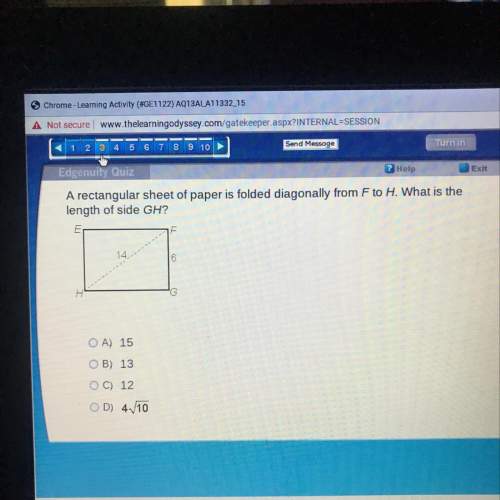PLEASE HELP ME!!
5.6.4 Practice - finding the constant in inverse variation
You and your fri...

Mathematics, 07.12.2021 23:40 destinypierre
PLEASE HELP ME!!
5.6.4 Practice - finding the constant in inverse variation
You and your friend see kids playing on a seesaw. The two kids are balancing without their feet touching the ground. Your friend says that there is no way that a mother and daughter could do the same thing. You are not sure if that is true.
Use what you know about the different types of variation to figure out how a mother and child could balance. Use the Lever Tool to verify the data, and then use what you know about variation to model the relationship between weight and distance from the fulcrum.
1. Use the Lever Tool to verify each weight and distance pair given in the video for your seesaw. Write the values in the table below. (Note: The pan on the lever weighs 100 units!) (1 point)
A: B:
Analyzing your data
2. Use the data from the table to make a graph. (3 points: 1 point each for labels, coordinates, and sketch)
3. Does it look as though there is a relationship between the weight and its distance from the fulcrum? What type of variation is there (if any)? Support your answer. (1 point)
4. Write an equation that models your data. Use variables of weight, W, and distance, D. (You will have to use one of your data points to find your constant of variation.) (3 points: 1 point for the general form of variation, 1 point for the constant of variation, and 1 point for the final equation)
5. The Lever Tool helps find values that will balance your seesaw, but it has limited range and precision. Use your graph to estimate a coordinate (W, D) that: balances your seesaw
you could not simulate with the Lever Tool
To verify that your values are reasonable, substitute your coordinate into the equation you found in question 4. Is the coordinate you picked a good solution?
(3 points: 1 point for a value that cannot be shown on the Lever Tool, 1 point for the correct substitution, and 1 point for verification)
A new balance
Your turn: Choose a new fixed weight and fixed difference that are different from the one for the seesaw you selected. (Reminder: Seesaw A has a fixed weight of 600 units and a fixed distance of 150 units. Seesaw B has a fixed weight of 100 units and a fixed distance of 120 units.)
6. What new values did you pick? (1 point)
7. With your new constant values on one side of the seesaw, use the Lever Tool to find 5 new pairs of weights and distances that balance the seesaw. Record these values in the table below. (Reminder: The pan on the lever weighs 100 units!) (2 points)
Weight
Distance
8. Now use the table to sketch a graph. (3 points: 1 point each for labels, coordinates, and sketch)
9. Write an equation that represents your data and graph. Write your equation in terms of weight, W, and distance, D. (You will have to use one of your data points or your fixed point to find your constant of variation.) (3 points: 1 point for the general form of variation, 1 point for the constant of variation, and 1 point for the final equation)

Answers: 1
Another question on Mathematics

Mathematics, 21.06.2019 19:00
What are the solutions of the system? solve by graphing. y = x^2 + 3x + 2 y = 2x + 2
Answers: 1

Mathematics, 21.06.2019 19:40
Atextile fiber manufacturer is investigating a new drapery yarn, which the company claims has a mean thread elongation of 12 kilograms with a standard deviation of 0.5 kilograms. the company wishes to test the hypothesis upper h subscript 0 baseline colon mu equals 12 against upper h subscript 1 baseline colon mu less-than 12 using a random sample of n equals 4 specimens. calculate the p-value if the observed statistic is x overbar equals 11.8. round your final answer to five decimal places (e.g. 98.76543).
Answers: 3


Mathematics, 21.06.2019 23:50
Which statement explains how you could use coordinate geometry to prove the opposite sides of a quadrilateral are congruent? a. use the slope formula to prove the slopes of the opposite sides are the same. b. use the slope formula to prove the slopes of the opposite sides are opposite reciprocals. c. use the distance formula to prove the lengths of the opposite sides are the same. d. use the distance formula to prove the midpoints of the opposite sides are the same.
Answers: 3
You know the right answer?
Questions




History, 01.12.2020 20:20

Mathematics, 01.12.2020 20:20

Mathematics, 01.12.2020 20:20

Social Studies, 01.12.2020 20:20

Mathematics, 01.12.2020 20:20




Mathematics, 01.12.2020 20:20

Mathematics, 01.12.2020 20:20

Physics, 01.12.2020 20:20

Mathematics, 01.12.2020 20:20


Mathematics, 01.12.2020 20:20

Spanish, 01.12.2020 20:20





